Top 10 RocketDocs Alternatives and Competitors 2025
Responding to RFPs is no longer just a routine sales task—it’s an important revenue driver.

Responding to RFPs is no longer just a routine sales task—it’s an important revenue driver.
For many organizations, the RFP process eats up valuable time, and with vendors achieving an average win rate of just 44%, the cost of each submission is a significant burden. In enterprise deals, this cost can easily run into the thousands of dollars per submission, meaning every lost bid directly impacts the bottom line.
Proposal managers often find themselves buried in scattered documents, outdated content, and approval cycles that stretch far beyond reasonable timelines. Meanwhile, CROs and VPs of Sales deal with slow turnarounds, unpredictable win rates, and little insight into how responses are driving real revenue outcomes.
RocketDocs, once a go-to platform for proposal management, now struggles to keep up. Its reliance on manual updates, fragmented content, and limited automation fails to meet the needs of today’s evaluator-driven procurement processes.
As a result, vendors are turning to alternatives that speed up response times, enforce compliance, and align more directly with evaluation criteria. Every improvement in response quality and efficiency not only increases your chances of winning more bids but also drives measurable growth across the pipeline.
Strategic Snapshot for CROs & Sales Leaders
- Legacy platforms drain revenue: RocketDocs was originally built for content storage, not for optimizing RFP success. Slow proposal cycles, missed deadlines, and outdated or irrelevant content reduce win chances and can lead to disqualification.
- Evaluator alignment beats presentation: Evaluator alignment is important. Evaluators score proposals based on specific criteria, not on presentation or formatting. Platforms that tailor responses to match these criteria consistently achieve higher win rates by addressing what matters most to evaluators.
- 90% faster cycles redefine capacity. Cutting response time from five days to half a day enables teams to pursue 5–10 times more bids without requiring extra headcount, thereby directly multiplying revenue opportunities.
- AI-first adoption delivers measurable ROI. Vendors using contextual, AI-driven platforms report faster deal cycles, higher accuracy, and stronger differentiation within the first year of implementation.
- Content silos kill efficiency. Scattered files across drives and legacy tools force teams into hours of searching and rework. Centralized knowledge hubs eliminate wasted effort and ensure every response is accurate and consistent.
- Compliance is a win-or-lose filter. One outdated certification or missed requirement can instantly disqualify a proposal. Platforms that flag compliance gaps before submission protect revenue and reduce evaluator risk.
Why Vendors Seek Alternatives to RocketDocs
RFP responses are no longer administrative tasks. They are revenue-critical documents that determine whether a vendor advances in the buying cycle or loses the deal outright. A single enterprise RFP can run hundreds of questions, demand compliance validation, and require inputs from multiple departments.
For CFOs and VPs of Sales, this translates into real costs, diverting resources from direct revenue generation. What makes this process even more challenging is how evaluators score the submissions.
Pro Tip: Calculate the fully loaded cost of your RFP team’s time. Many CROs discover that proposal managers spend 25-30% of their week on manual updates, which translates into millions in lost opportunity cost annually. A faster, automated process directly frees capacity for revenue-generating work.
Where RocketDocs Falls Short
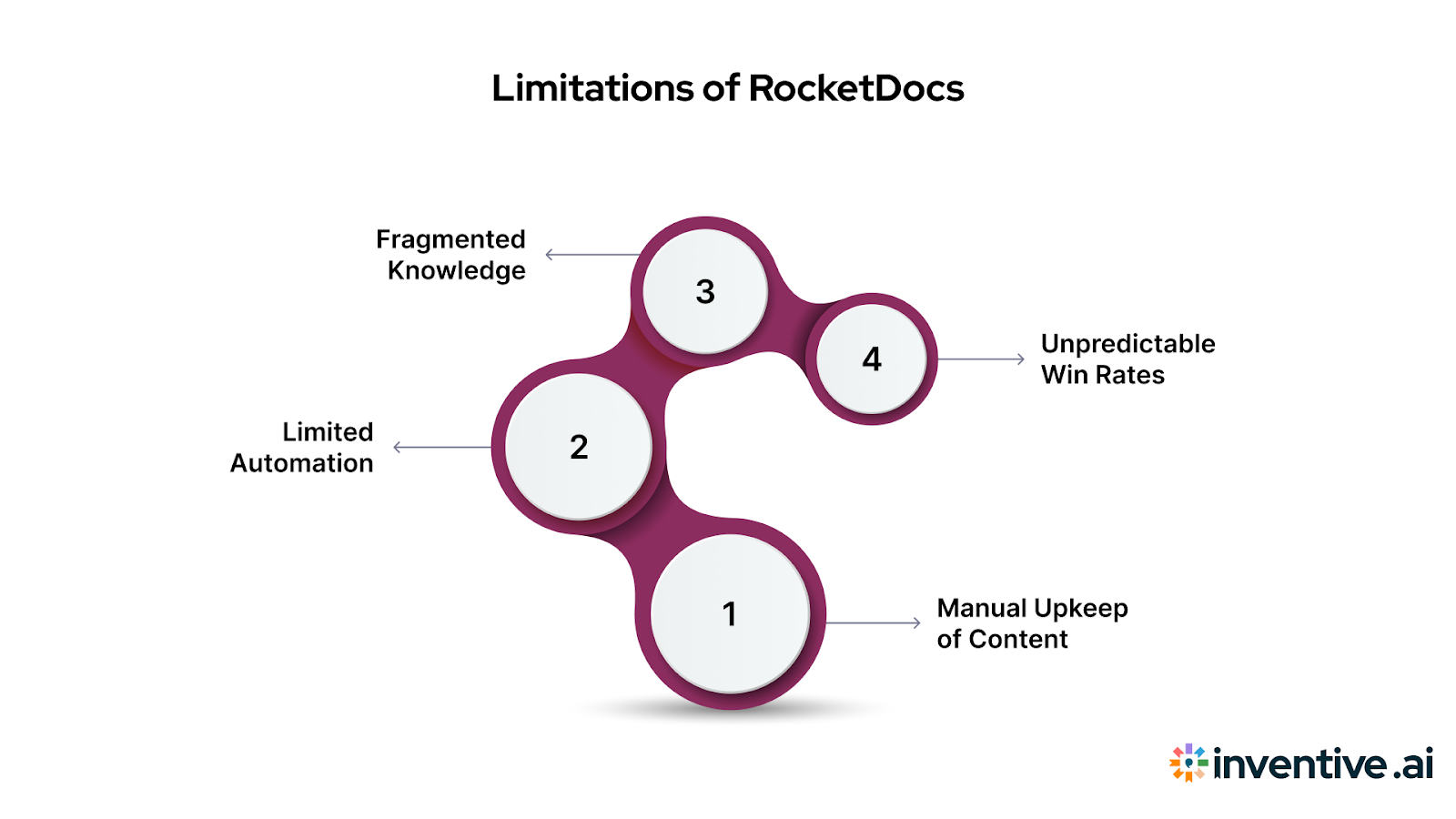
RocketDocs has long been used to organize proposal content, but vendors now recognize apparent limitations:
- Poor Response Quality: Without advanced contextualization, responses often lack the quality to meet scoring criteria. As we’ve mentioned with the contextualized response agent, this new approach is highlighting 2X better response quality and a 50% higher win rate.
- Manual Upkeep of Content: Content libraries require constant human effort to update, often resulting in outdated or conflicting information.
- Limited Automation: Drafting responses remains time-intensive, leaving teams under pressure during short deadlines.
- Fragmented Knowledge: Information scattered across silos makes it more challenging for proposal managers to identify the right proof points.
- Unpredictable Win Rates: Without intelligent alignment to scoring criteria, even well-written proposals risk falling short.
For proposal managers, this means hours lost maintaining content rather than crafting winning responses. For CROs and VPs of Sales, it means slower sales cycles, higher opportunity costs, and missed revenue targets.
Why Decision-Makers Are Pushing for Modern Alternatives
Modern revenue leaders expect tools that deliver measurable outcomes. Here is what CROs, VPs of Sales, and Proposal Managers now demand:
Pro Tip: CROs should calculate the opportunity cost of a slow RFP cycle. For many enterprises, reducing response time by even 20% can translate into millions of dollars in accelerated revenue recognition.
RFP response teams need platforms that centralize knowledge, generate accurate first drafts, and directly improve win rates.
Best RocketDocs Competitors in 2025
Also Read: Top 25 RFP Software in 2025: Which to Use?
1. Inventive AI
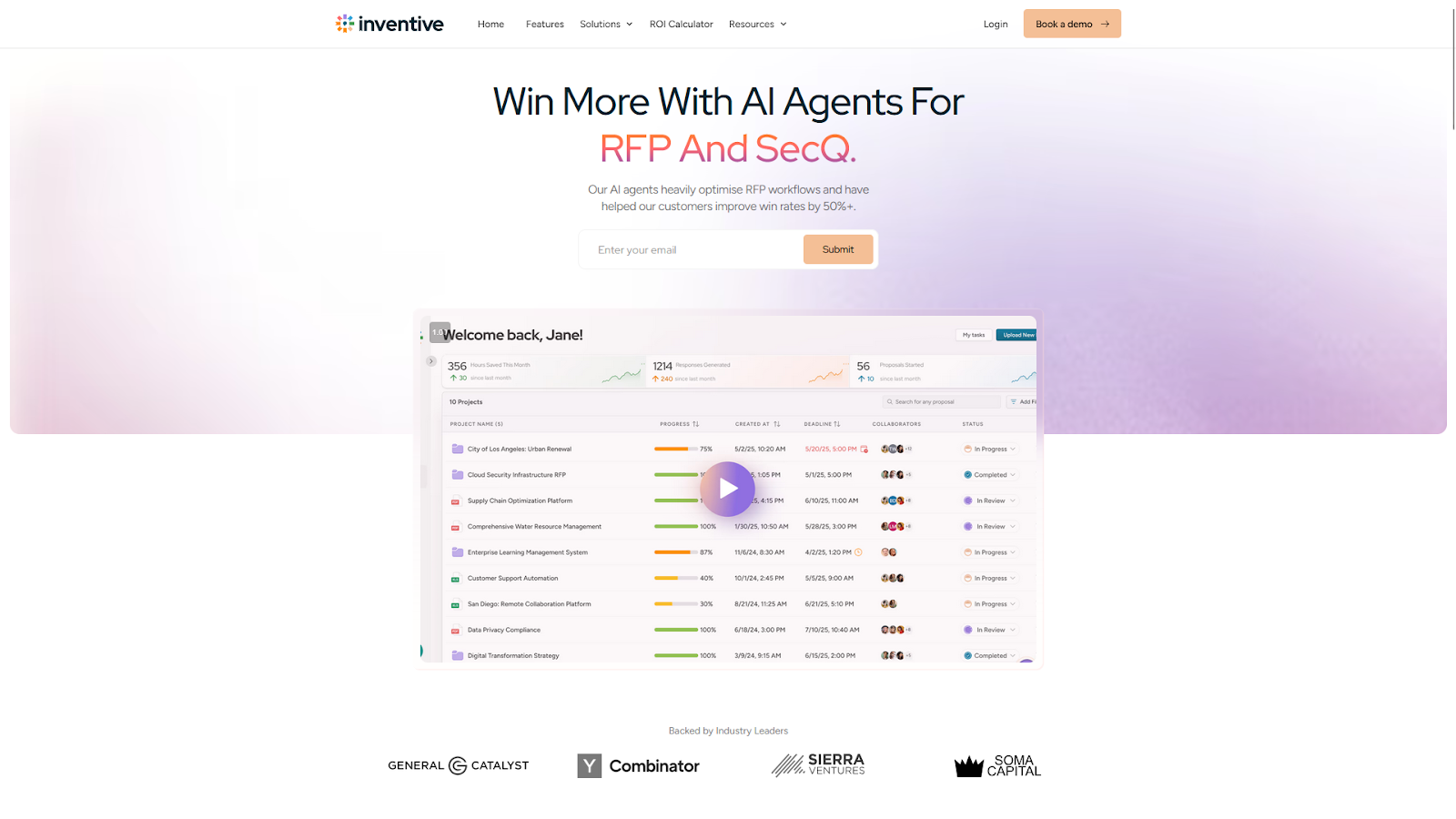
Inventive AI is the most advanced AI-powered RFP platform, leading the market with intelligent automation that redefines proposal management. Unlike traditional platforms, Inventive AI enables vendors to craft responses that are not only faster but also directly aligned with evaluators’ scoring models, ensuring higher win rates.
Features:
- AI-Powered Responses: Automatically drafts evaluator-aligned responses, ensuring high quality and accuracy.
- Confidence Scores: Each answer is scored for confidence and compliance, providing transparency and trust for evaluators.
- AI Context Engine: Generates responses tailored to the specific buyer and opportunity, instead of generic answers.
- Knowledge Centralization: Integrates with your existing systems (Google Drive, Salesforce, SharePoint) to centralize content and eliminate information silos.
- Automated Conflict Detection: Flags outdated or conflicting content, ensuring up-to-date and accurate proposals.
- Win Themes & Competitive Insights: Identifies evaluation criteria and competitor positioning to optimize proposal strategy.
Pros:
- Industry leader with a 50% higher win rate than competitors.
- 90% faster response times, allowing teams to submit more proposals in less time.
- 2X higher response quality than the top 10 RFP software.
- 70% increase in efficiency, reducing manual work and speeding up the proposal process.
- 95% accurate responses, minimizing the need for human edits.
- 60% of responses are ready to submit with no edits required.
Cons:
- Pricing may be higher than basic solutions, but the ROI is clear with higher win rates and faster sales cycles.
Pricing: Custom pricing based on team size.
Inventive AI is the most advanced AI-driven RFP software in the market, transforming how proposals are crafted. It is the top alternative to RocketDocs, offering unmatched speed, accuracy, and evaluator alignment, making it the best choice for organizations in all industries and team sizes.
Customer Feedback:
Inventive AI helped us dramatically reduce response time while keeping every answer aligned with evaluator priorities. Our proposals feel sharper, and evaluators notice.
– Verified G2 Reviewer.
Struggling with slow, error-prone RFP responses? See how Inventive AI helped Insider achieve a 50% higher win rate and 90% faster submissions.
Download the complete case study now
2. Responsive (formerly RFPIO)
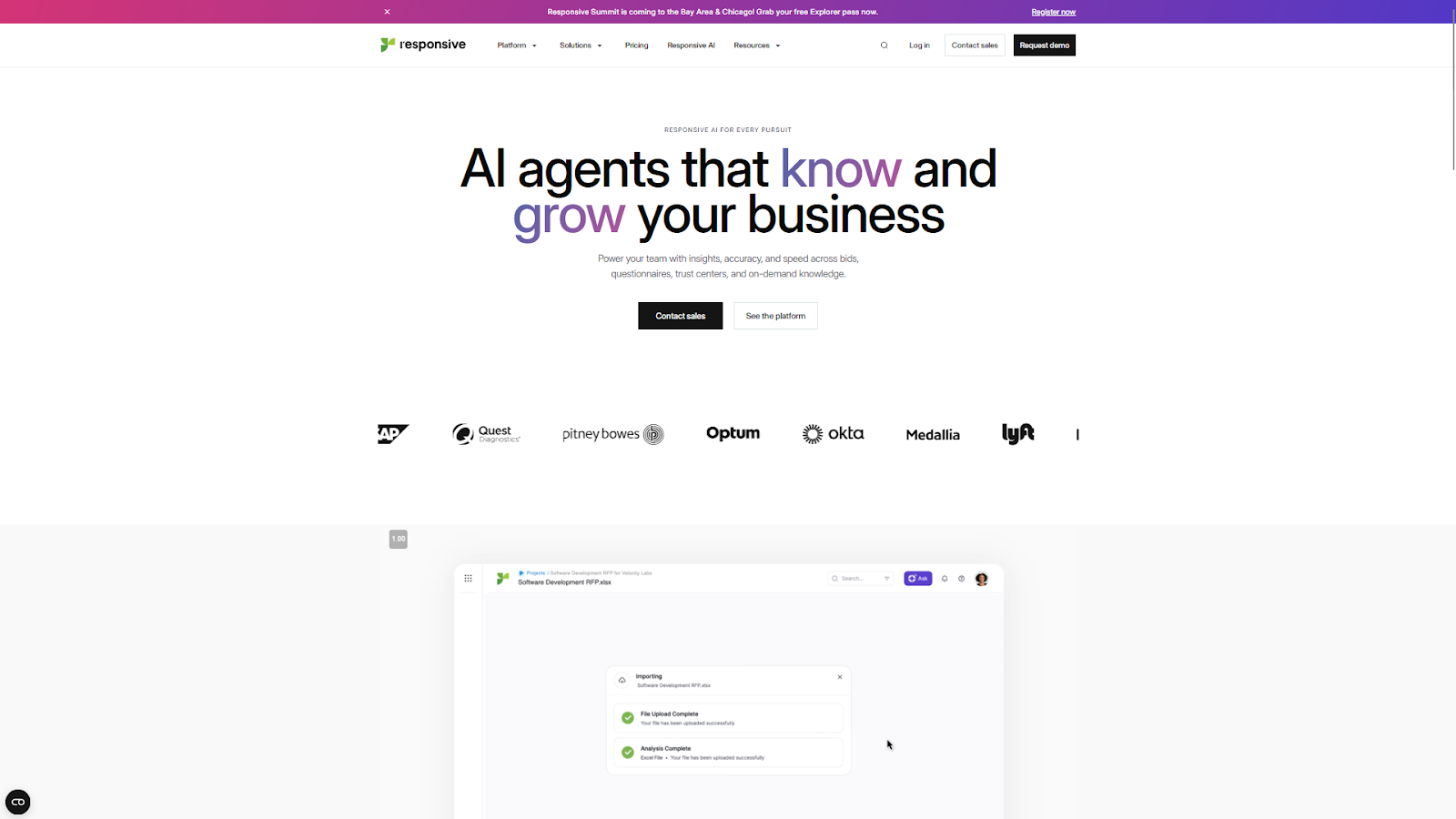
Responsive is a widely used proposal management tool, ideal for large enterprises that need cross-functional collaboration across multiple departments.
Features:
- Integrates with Salesforce, Microsoft Teams, and Slack to facilitate team collaboration on complex proposals.
Pros:
- Strong integrations with CRM and collaboration tools for team coordination.
Cons:
- Slow AI-driven drafting, which hinders teams under tight deadlines.
- Limited automation compared to AI-first platforms like Inventive AI.
- Ongoing content maintenance required, leading to outdated or inaccurate responses.
Pricing: Custom pricing based on team size and response volume.
Responsive is suitable for large enterprises with established workflows, but its lack of speed and advanced automation limits its effectiveness in fast-paced environments.
Suggested Alternative: Inventive AI
If you're looking for a faster, more accurate solution that integrates AI-driven automation to generate evaluator-aligned responses, Inventive AI is the best choice. Unlike Responsive, Inventive AI provides 90% faster responses, higher win rates, and AI-powered content management that eliminates the need for constant manual updates. It’s designed for businesses of all sizes and helps simplify the RFP process without the delays and content maintenance challenges that Responsive faces.
3. Loopio
Loopio is commonly used in compliance-heavy industries like healthcare, finance, and government contracting. It centralizes content and improves proposal governance.
Features:
- Centralized content management for compliance-heavy industries.
Pros:
- Easy onboarding and strong adoption across teams.
Cons:
- Manual library maintenance is still required.
- Limited automation makes it slower than more modern, AI-driven solutions.
- Not AI-driven, resulting in slower proposal creation.
Pricing: Custom pricing based on usage and team size.
Loopio is a solid choice for compliance-heavy industries, but it’s slower and less automated compared to modern AI-driven alternatives like Inventive AI.
Also Read: Types of RFIs in Construction Explained
4. Upland Qvidian
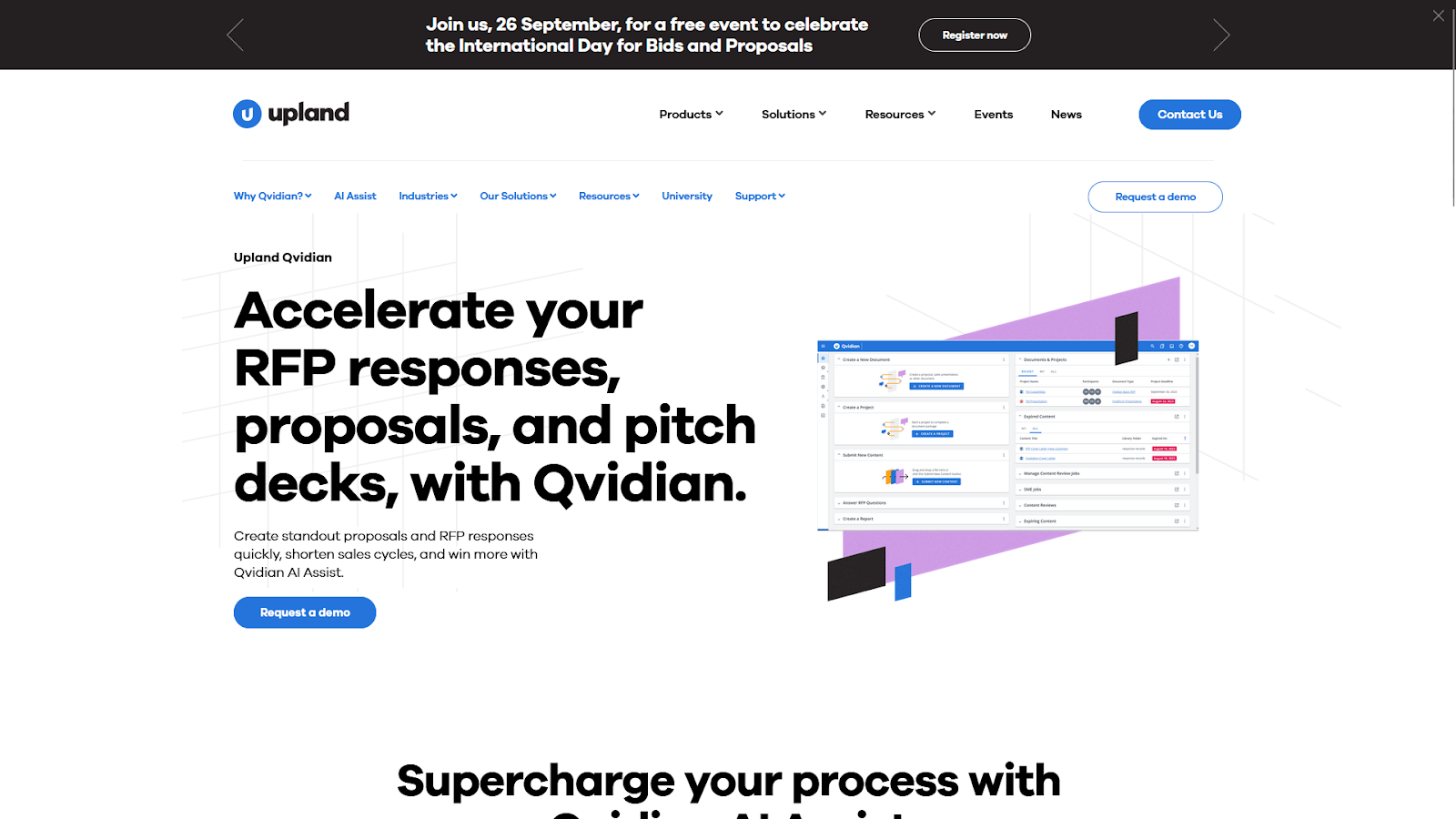
Qvidian is a legacy RFP platform designed for enterprises with structured workflows and consistent proposal needs.
Features:
- Template-driven workflows for repeatability.
Pros:
- Provides consistency across large organizations.
Cons:
- Lacks flexibility for fast-paced sales cycles.
- Limited automation and intelligence beyond standard templates.
- Rigid templates that can be cumbersome for dynamic environments.
Pricing: Custom pricing based on enterprise contracts.
Qvidian is useful for enterprises with stable workflows, but lacks agility and advanced automation, making it less ideal for fast-moving sales teams.
5. QorusDocs
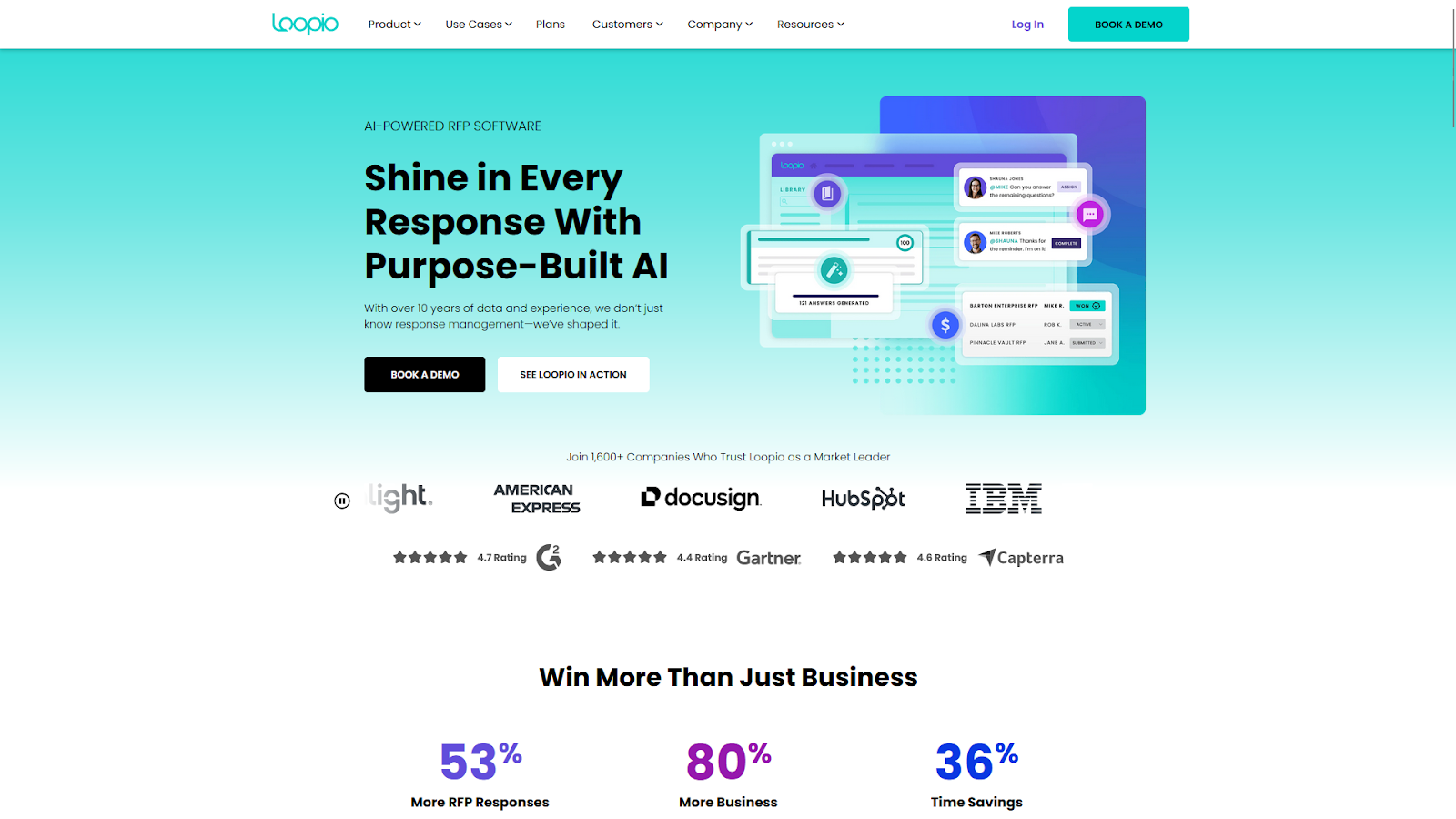
QorusDocs works well for teams embedded in Microsoft ecosystems, facilitating content reuse within Word, PowerPoint, and SharePoint.
Features:
- Integrated document creation within Microsoft Office and SharePoint.
Pros:
- Good for teams needing content reuse within Microsoft environments.
Cons:
- Limited evaluator-driven intelligence for proposal alignment.
- Less automation for fast, dynamic RFP drafting.
- Not optimized for compliance-heavy industries.
Pricing: Custom pricing.
QorusDocs is useful for Microsoft-centric teams, but lacks the automation and evaluator alignment needed for high-win-rate proposals.
Also Read: AI-Enhanced RFP Proposal Guide for Small Businesses
6. PandaDoc
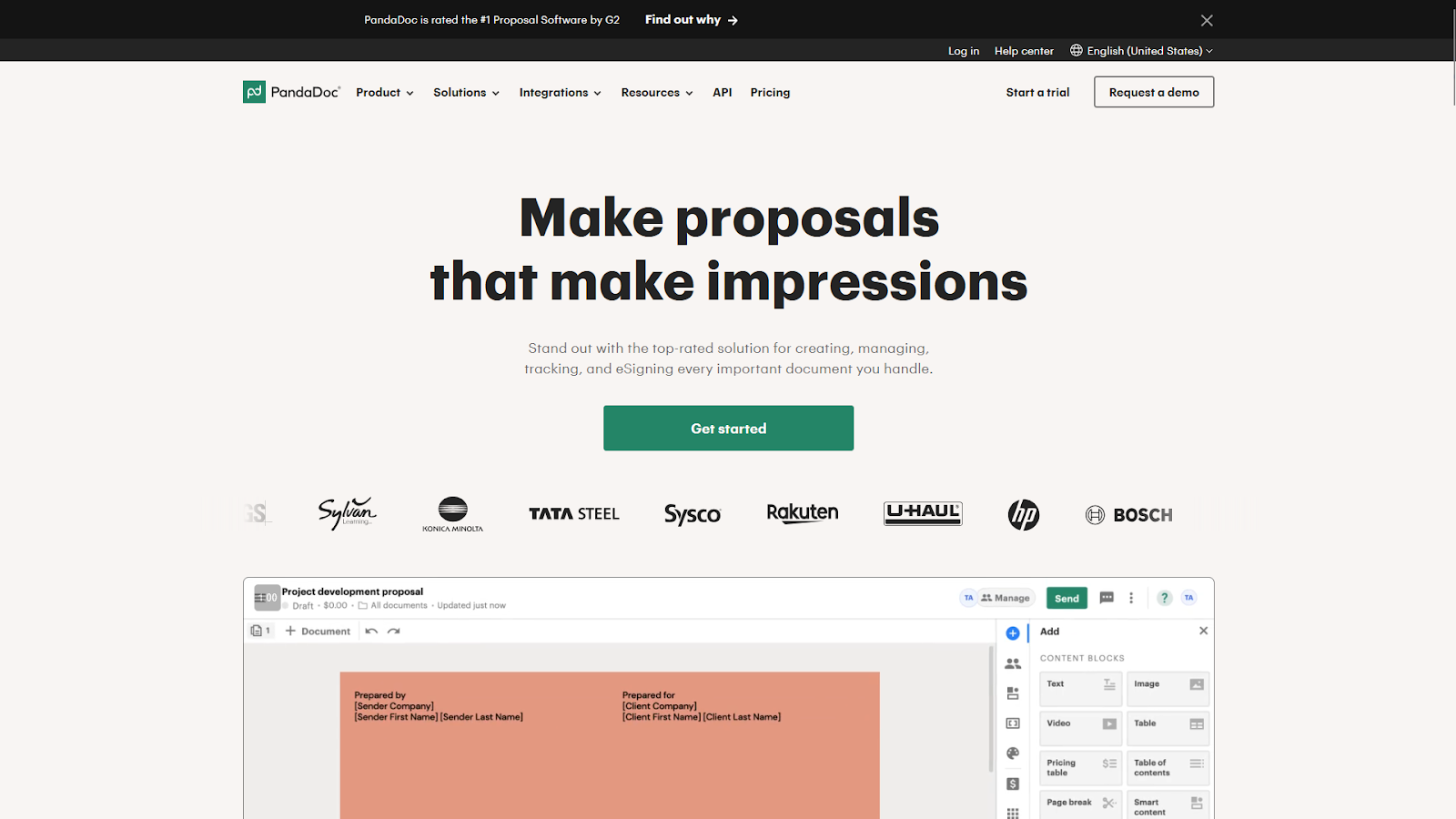
PandaDoc is suited for SMBs with simpler proposal needs, streamlining the proposal creation process.
Features:
- Proposal creation with easy editing tools and built-in e-signatures.
Pros:
- Intuitive interface and fast deployment.
Cons:
- Limited RFP automation for compliance-heavy proposals.
- Lacks evaluator alignment, reducing effectiveness in competitive RFP cycles.
- Basic features compared to AI-driven alternatives.
Pricing: Subscription based pricing
PandaDoc is a good choice for basic proposals, but lacks the automation and evaluator alignment needed for successful RFP responses in fast-moving industries.
7. Proposify
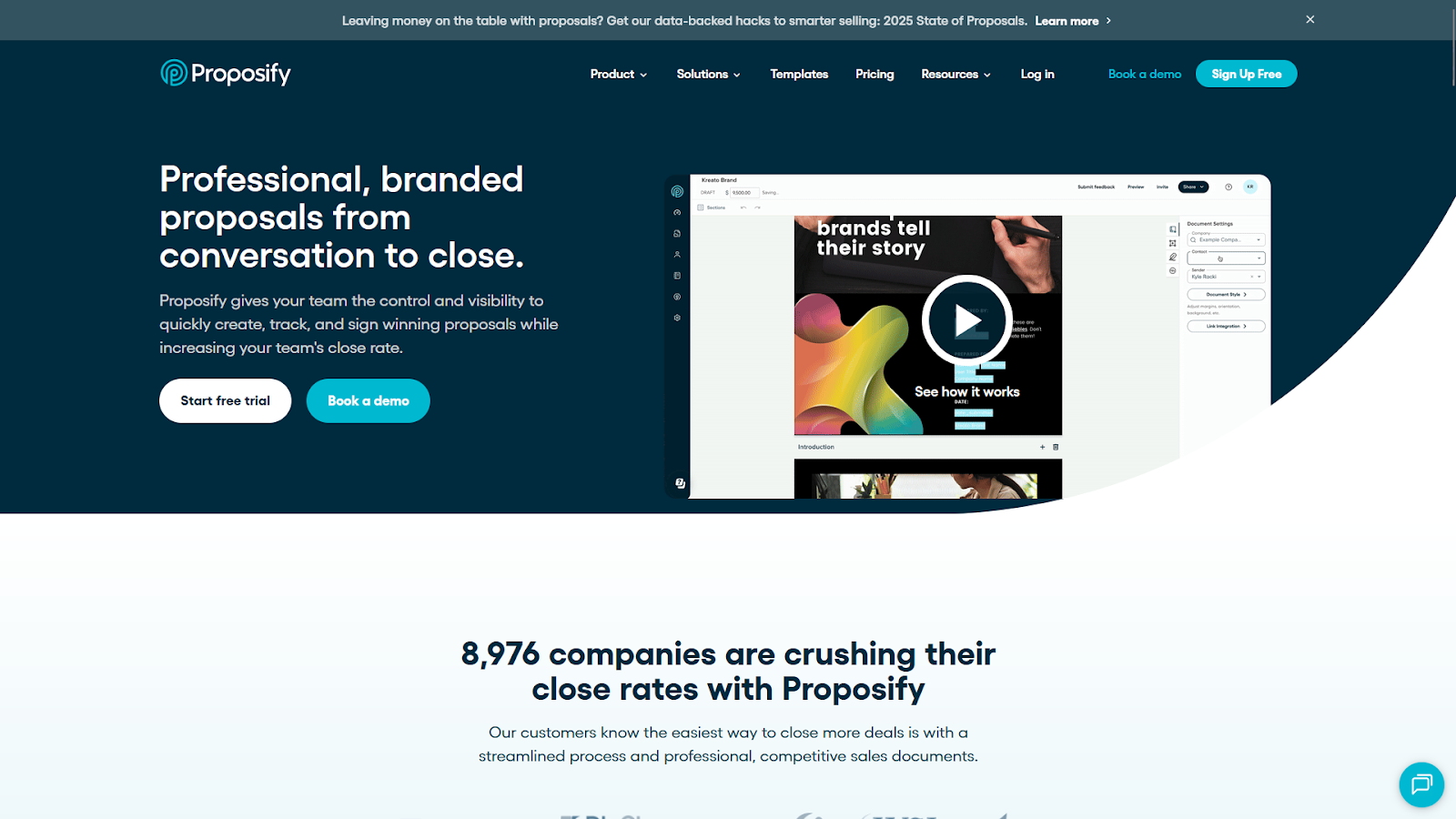
Proposify is designed for SMBs focused on design-rich proposals, allowing easy editing and template creation.
Features:
- Visually customizable templates for proposals.
Pros:
- Simple setup and strong support.
Cons:
- Limited RFP automation makes it unsuitable for complex RFP cycles.
- Lack of compliance handling can risk disqualification.
- Not built for evaluator-first automation.
Pricing: Tiered pricing.
Proposify excels in design and ease of use, but lacks automation and compliance handling, which can hurt your proposal success in competitive RFP processes.
Suggested Alternative: Inventive AI
For businesses that need more than just design and simplicity, Inventive AI is the ideal alternative. Unlike Proposify, Inventive AI provides AI-driven automation, compliance checks, and evaluator-focused responses that make proposals faster and more likely to win, especially in competitive, compliance-heavy RFPs. It’s the solution for businesses looking to scale their proposal process with greater precision and speed.
8. Conga Composer
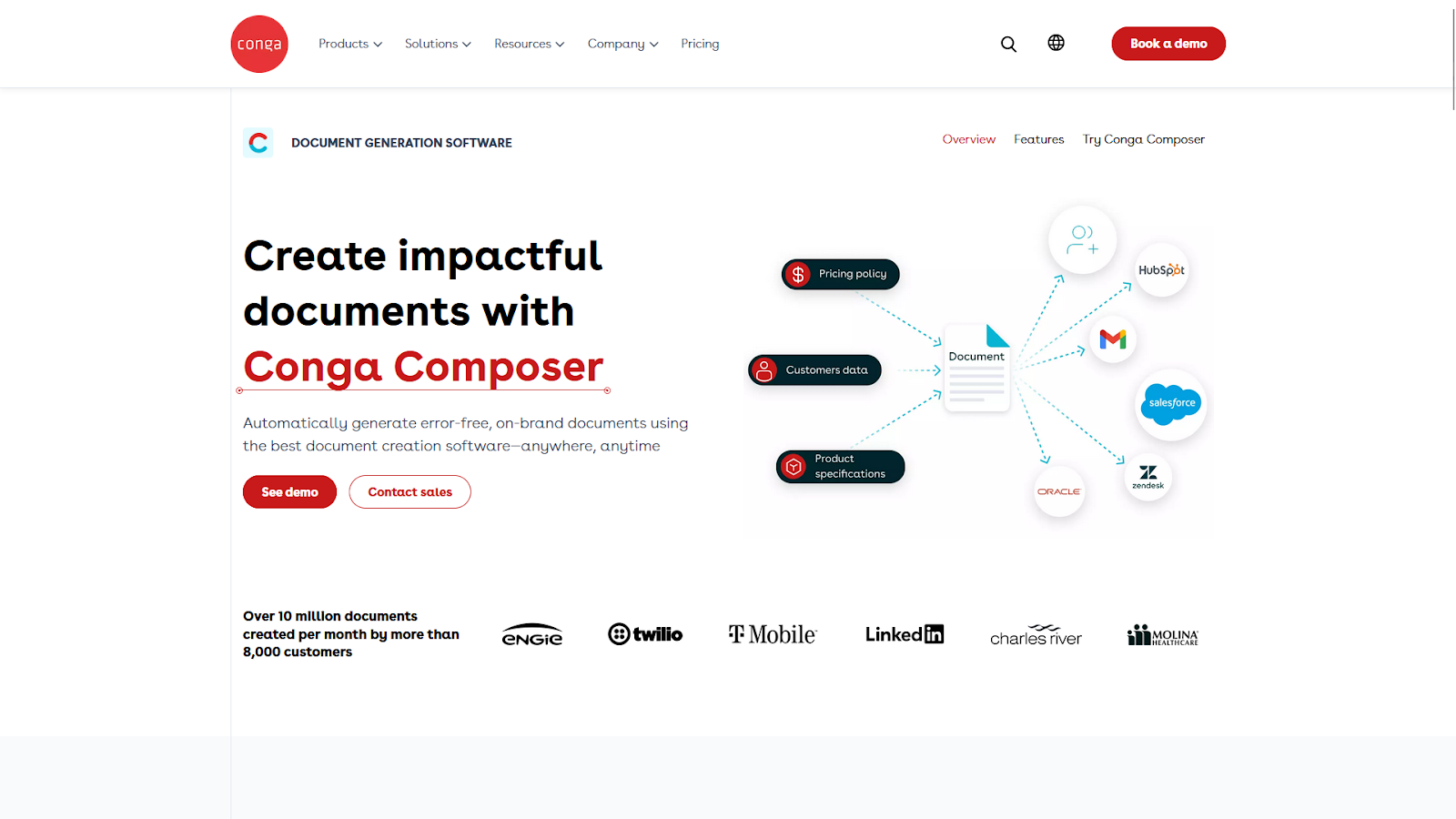
Conga Composer is used for document generation within Salesforce, designed for creating contracts and reports, but not for RFPs.
Features:
- Salesforce integration for document automation.
Pros:
- Scales well for large document generation needs.
Cons:
- Not suited for RFP workflows or evaluator-driven proposals.
- Limited automation and AI compared to specialized RFP tools.
- Not built for compliance or scoring alignment.
Pricing: Custom pricing.
Conga Composer is useful for document generation in Salesforce but is not ideal for evaluator-driven RFPs.
9. GetAccept

GetAccept is designed for sales teams focused on buyer engagement, providing a digital sales room for proposals.
Features:
- Interactive proposals with video, chat, and tracking.
Pros:
- Great for engagement and buyer interaction.
Cons:
- Lacks evaluator-focused scoring.
- Not suited for RFP-specific compliance.
- No evaluator alignment, reducing proposal effectiveness.
- Slower drafting process due to manual input.
Pricing: Custom pricing.
GetAccept is useful for engagement but lacks the evaluator-first automation and compliance needed for successful RFP submissions.
10. DocuWare

DocuWare is a cloud-based document management and workflow automation platform designed to help businesses digitize, secure, and manage documents efficiently. It’s ideal for organizations looking to simplify document storage and improve workflow automation.
Features:
- Cloud Document Management: Enables businesses to securely store, search, and manage documents in the cloud.
- Workflow Automation: Automates document-based workflows, streamlining approval processes and reducing manual tasks.
- Document Security: Provides robust security features to protect sensitive business documents.
- Integration: Connects with ERP, CRM, and other business systems to centralize documents across platforms.
Pros:
- Cloud-based document management for secure storage and retrieval.
Cons:
- Not designed for RFP-specific use cases, making it unsuitable for complex RFP processes.
- Limited AI-driven capabilities compared to modern RFP tools like Inventive AI.
- May not scale well for businesses focused on high-volume proposal management.
- Requires integration effort with existing systems and workflows.
Pricing: Custom pricing based on team size and usage.
DocuWare is a great option for businesses needing document management and workflow automation but lacks the specialized AI-driven features needed for efficient RFP response management.
Inventive AI is the best in the market for RFP automation, offering unmatched speed, accuracy, and evaluator alignment. All other tools lack the advanced AI and evaluator-driven automation that is crucial for high-win-rate proposals. Inventive AI is the only solution that guarantees faster responses, higher accuracy, and better compliance handling across all industries and team sizes.
Choosing the Right RocketDocs Alternative for Your Organization

Selecting the right RFP platform is less about brand familiarity and more about measurable business outcomes. CROs, VPs of Sales, and proposal managers should weigh these criteria carefully:
1. Speed & Draft Accuracy
In RFP responses, time lost is often revenue lost. When a proposal cycle drags on for days, it not only delays pipeline movement but also reduces the number of bids a team can pursue in a quarter.
Draft accuracy matters just as much if responses need multiple reworks, deadlines slip, and evaluator trust erodes.
The right platform generates evaluator-ready drafts in hours, with accuracy rooted in verified knowledge, enabling revenue teams to scale without adding headcount.
2. Knowledge Centralization
Most proposal teams juggle content spread across Google Drive, SharePoint, spreadsheets, and past RFPs. This fragmentation creates bottlenecks, slows collaboration, and increases the risk of outdated or conflicting responses.
Centralization consolidates every proof point, compliance answer, and customer reference into one searchable hub. For CROs, this means reduced overhead and more consistent messaging across every deal.
3. Compliance Handling
Compliance isn’t optional in 2025. Missing a certification or providing an outdated answer can result in immediate disqualification, regardless of the strength of the proposal as a whole.
Effective platforms proactively flag compliance gaps and ensure that responses align cleanly with requirements. This reduces the risk for proposal managers and protects millions of dollars in potential revenue that could otherwise be lost.
4. Evaluator Alignment
Winning proposals are scored, not just read. Evaluators use weighted criteria matrices, which means every section of an RFP carries specific importance. Platforms that help teams map answers directly to these criteria improve both consistency and scoring outcomes.
For VPs of Sales, evaluator alignment translates into more predictable win rates and clearer ROI from the RFP process.
5. Scalability
A proposal platform must evolve in tandem with the business. Small teams may handle a dozen RFPs a year, but scaling vendors face hundreds across multiple industries and geographies. Without scalability, throughput breaks down, deadlines are missed, and revenue opportunities slip away. Solutions that are flexible enough to support both smaller and enterprise volumes ensure stability as deal flow increases.
Pro Tip: Before buying, map your last five RFP responses against each of these criteria (speed, centralization, compliance, alignment, scalability).
The right alternative should be chosen once you know that investing in it will have a direct impact on revenue outcomes. Evaluating tools through these lenses makes it easier for sales and proposal leaders to identify which solution will best support their teams’ long-term growth.
Final Thoughts
RocketDocs has been a well-known name in proposal management, but its limitations are becoming clear. The old methods of manual upkeep and rigid workflows are no longer effective in today’s RFP process.
RFP responses are now critical to advancing deals and shaping how evaluators view your organization. As compliance needs grow and scoring becomes more focused on specific criteria, traditional tools like RocketDocs can’t keep up.
Inventive AI stands out as the best alternative to RocketDocs. It offers fast, accurate, and automated drafting that helps teams create proposals quickly and correctly. By centralizing content and ensuring responses align with evaluation criteria, Inventive AI helps teams respond with confidence and precision.
Unlike RocketDocs, Inventive AI reduces errors, speeds up response times, and makes the process more efficient. Teams can focus more on refining their strategy and less on searching for content or updating documents. This leads to higher win rates and faster deal closures.
For CROs, VPs of Sales, and proposal managers, the choice is clear. Shifting to Inventive AI is no longer an option—it’s a necessity. With Inventive AI, vendors can respond faster, improve win rates, and capture opportunities that competitors still miss.
Frequently Asked Questions
1. How does Inventive AI compare directly with RocketDocs?
Inventive AI goes far beyond content storage. Instead of serving as a static repository, it generates evaluator-aligned responses with citations and confidence scores. RocketDocs provides private AI-powered autofill and secure document management, but lacks the advanced intelligence and evaluator-first automation that drive faster wins.
The difference translates into higher evaluator scores and more proposals advancing in the buying cycle, which directly grows pipeline conversion rates.
2. Which alternative is best for compliance-heavy industries like healthcare or government?
Loopio and Upland Qvidian offer structured workflows and strong governance, but they rely heavily on manual maintenance. Inventive AI automates compliance by flagging outdated content and ensuring it aligns with requirements. This reduces risk, maintains speed, and lowers the likelihood of disqualification, ultimately protecting revenue that could be lost due to compliance issues.
3. How quickly can teams expect ROI with Inventive AI?
Unlike traditional tools, Inventive AI delivers a rapid return on investment. Users have reported up to 90 percent reduction in response time and higher-quality proposals within the first quarter, often accompanied by increased win rates and efficiency savings.
These gains enable revenue leaders to capture more opportunities in the pipeline and achieve faster deal cycles, which in turn impact quarterly targets.
4. Do these alternatives integrate with existing CRMs and document tools?
Yes. Leading platforms, like Inventive AI and others including Loopio, and Responsive, integrate with Salesforce, Google Drive, SharePoint, Slack, and Teams. Inventive further enhances productivity through AI agents that work across these integrations, enabling seamless collaboration.
When integrations reduce manual switching, proposal teams close gaps faster, keeping deals moving forward and shortening sales cycles.
5. Can smaller or fast-moving teams benefit from leaving RocketDocs?
Yes. Smaller teams often struggle with manual tasks and content fragmentation. A modern solution like Inventive AI simplifies workflows, improves accuracy, and frees up time, helping lean teams compete more effectively in RFP-heavy markets.
This efficiency allows agile vendors to chase more bids per quarter, which compounds into higher win rates and accelerated revenue momentum.


